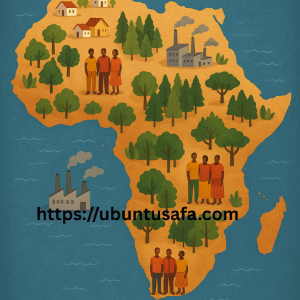Did You Know Ethiopia: Land of Living Letters — The Legacy of Ge’ez and Written Tradition Where African Language, Literacy, and Literature Flourished for Millennia

In the long arc of African history, oral tradition has been the backbone of many cultures — preserving knowledge through storytelling, music, and memory. Yet in the highlands of Ethiopia, something extraordinary took place: a powerful written tradition emerged, was nurtured, and continues to thrive today.
Ethiopia is one of the only African civilizations to have developed and preserved its own unique script — Ge’ez — and to have cultivated a continuous culture of writing across millennia. This has made Ethiopia not just a guardian of ancient languages, but a beacon of African intellectual heritage.
The Ge’ez Script: An African Invention
The Ge’ez script, also known as Fidel, is a syllabic writing system used to write the Ge’ez language — and later adapted to modern Ethiopian languages like Amharic, Tigrigna, and Tigre.
Unlike alphabets like Latin or Arabic, Ge’ez is a featural script that combines consonants with vowel modifications into a unified character. It is elegant, phonetic, and entirely indigenous to Ethiopia.
Origins:
-
Developed from the South Arabian script used during the Kingdom of D’mt (c. 1000 BCE), Ge’ez evolved into a fully independent script by the Aksumite period (c. 100 CE).
-
It was initially written without vowels (abjad) but eventually became a full syllabary, enabling precise expression of the language.
Importance:
-
Ge’ez became the liturgical and scholarly language of Ethiopia.
-
It is still used today in Ethiopian Orthodox, Catholic, and Beta Israel (Jewish) communities for prayers, religious texts, and hymns.
-
Its continued use makes Ethiopia one of very few African nations with a native script still in active liturgical and cultural use.
A Continuous Written Culture
While much of sub-Saharan Africa passed down knowledge through oral traditions — noble in their own right — Ethiopia stands apart for cultivating a written literary culture that spans over 2,000 years.
Ancient Manuscripts:
Thousands of handwritten manuscripts survive in monasteries, churches, libraries, and private collections across Ethiopia. These are not only religious texts but also writings on:
-
Theology and Biblical studies
-
Astronomy and mathematics
-
Medicine and healing practices
-
Law, philosophy, and ethics
-
Royal chronicles and imperial history
Many of these works were painstakingly copied by monks on goatskin parchment, written in Ge’ez with natural inks, and bound in wooden covers. Each manuscript is a piece of sacred art — adorned with illuminated illustrations, cross motifs, and iconic Ethiopian styles.
Centers of Learning:
-
Monasteries like Debre Damo, Lake Tana Islands, and Abuna Yemata Guh became centers of scholarship, preserving Ethiopia’s literary legacy through centuries of change and challenge.
-
Monks were not only spiritual guides, but also philosophers, scientists, and scribes — keepers of intellectual tradition.
From Ge’ez to the Living Languages
Although Ge’ez is now used primarily in religious contexts, it lives on through its descendant languages, including:
-
Amharic – the official working language of modern Ethiopia.
-
Tigrigna – spoken in northern Ethiopia and neighboring Eritrea.
-
Tigre – spoken in parts of Eritrea and Sudan.
These languages retain Ge’ez script as their writing system, demonstrating an unbroken link between ancient and modern Ethiopian identity. In fact, many Ethiopians today still read and write using a script developed more than 1,600 years ago — a continuity that few cultures in the world can claim.
Ethiopia’s Intellectual Independence
This literary tradition also reflects Ethiopia’s civilizational independence. While colonial influence wiped out or disrupted indigenous scripts in many African nations, Ethiopia was never colonized, allowing its language and script to flourish uninterrupted.
It is a profound reminder that Africa has always had centers of literacy, learning, and intellectual creativity — long before colonial contact, and independent of foreign systems.
A Global Treasure
Today, efforts are being made to digitize and preserve Ethiopia’s manuscript treasures. Projects led by institutions like the British Library, Ethiopian Orthodox monasteries, and universities are helping to catalog and study these priceless cultural texts.
But make no mistake: these manuscripts are not just ancient relics. They are living testaments to the literacy, curiosity, and faith of a civilization that continues to inspire.
In Conclusion
Ethiopia’s story is one written in stone and scribed on parchment — a story told not only through song or memory, but through letters carved into the soul of a people.
-
In the Ge’ez script, we see a link between past and present.
-
In the thousands of ancient manuscripts, we glimpse an Africa that wrote, reasoned, and reflected deeply.
-
And in the living languages spoken today, we hear the echo of ancient voices — still vibrant, still proud.
Ethiopia is not just a cradle of humanity.
It is a cradle of African literacy.
A nation that speaks with its own voice — and writes in its own hand.
- Questions and Answers
- Opinion
- Motivational and Inspiring Story
- Technology
- Live and Let live
- Focus
- Geopolitics
- Military-Arms/Equipment
- Security
- Economy
- Beasts of Nations
- Machine Tools-The “Mother Industry”
- Art
- Causes
- Crafts
- Dance
- Drinks
- Film/Movie
- Fitness
- Food
- Games
- Gardening
- Health
- Home
- Literature
- Music
- Networking
- Other
- Party
- Religion
- Shopping
- Sports
- Theater
- Health and Wellness
- News
- Culture

